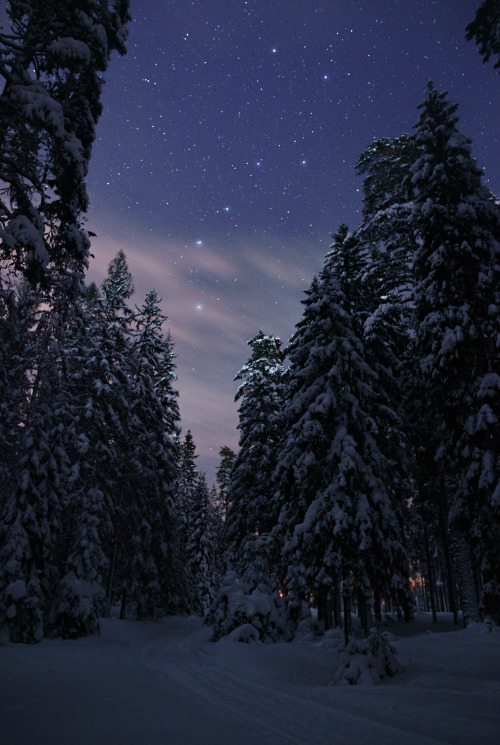The View Toward M101 : Big, Beautiful Spiral Galaxy M101 Is One Of The Last Entries In Charles Messier’s

The View Toward M101 : Big, beautiful spiral galaxy M101 is one of the last entries in Charles Messier’s famous catalog, but definitely not one of the least. About 170,000 light-years across, this galaxy is enormous, almost twice the size of our own Milky Way galaxy. M101 was also one of the original spiral nebulae observed by Lord Rosse’s large 19th century telescope, the Leviathan of Parsontown. M101 shares this modern telescopic field of view with spiky foreground stars within the Milky Way and a companion dwarf galaxy NGC 5474 (lower right). The colors of the Milky Way stars can also be found in the starlight from the large island universe. Its core is dominated by light from cool yellowish stars. Along its grand design spiral arms are the blue colors of hotter, young stars mixed with obscuring dust lanes and pinkish star forming regions. Also known as the Pinwheel Galaxy, M101 lies within the boundaries of the northern constellation Ursa Major, about 23 million light-years away. NGC 5474 has likely been distorted by its past gravitational interactions with the dominant M101. via NASA
More Posts from Monstrous-mind and Others
🔭🌃🌌

Ocean on the moon Europa
Scientists' consensus is that a layer of liquid water exists beneath Europa's surface, and that heat from tidal flexing allows the subsurface ocean to remain liquid.

Europa's surface temperature averages about 110 K (−160 °C; −260 °F) at the equator and only 50 K (−220 °C; −370 °F) at the poles, keeping Europa's icy crust as hard as granite. The first hints of a subsurface ocean came from theoretical considerations of tidal heating (a consequence of Europa's slightly eccentric orbit and orbital resonance with the other Galilean moons). Galileo imaging team members argue for the existence of a subsurface ocean from analysis of Voyager and Galileo images.

The most dramatic example is "chaos terrain", a common feature on Europa's surface that some interpret as a region where the subsurface ocean has melted through the icy crust.
The thin-ice model suggests that Europa's ice shell may be only a few kilometers thick. However, most planetary scientists conclude that this model considers only those topmost layers of Europa's crust that behave elastically when affected by Jupiter's tides.

The Hubble Space Telescope acquired an image of Europa in 2012 that was interpreted to be a plume of water vapour erupting from near its south pole The image suggests the plume may be 200 km (120 mi) high, or more than 20 times the height of Mt. Everest.
Life?
So far, there is no evidence that life exists on Europa, but Europa has emerged as one of the most likely locations in the Solar System for potential habitability. Life could exist in its under-ice ocean, perhaps in an environment similar to Earth's deep-ocean hydrothermal vents. Even if Europa lacks volcanic hydrothermal activity, a 2016 NASA study found that Earth-like levels of hydrogen and oxygen could be produced through processes related to serpentinization and ice-derived oxidants, which do not directly involve volcanism.

In 2015, scientists announced that salt from a subsurface ocean may likely be coating some geological features on Europa, suggesting that the ocean is interacting with the seafloor. This may be important in determining if Europa could be habitable. The likely presence of liquid water in contact with Europa's rocky mantle has spurred calls to send a probe there.
Missions

Europa Clipper is an interplanetary mission in development by NASA comprising an orbiter. Set for a launch in October 2024, the spacecraft is being developed to study the Galilean moon Europa through a series of flybys while in orbit around Jupiter.

The Europa Lander is a proposed astrobiology mission concept by NASA to Europa, an icy moon of Jupiter. If funded and developed as a large strategic science mission, it would be launched in 2027 to complement the studies by the Europa Clipper orbiter mission and perform analyses on site. NASA's budget for fiscal year 2021 neither mandates nor allocates any funds to the mission leaving its future uncertain.
The objectives of the mission are to search for biosignatures at the subsurface ≈10 cm, to characterize the composition of non-ice near-subsurface material, and determine the proximity of liquid water and recently erupted material near the lander's location.
source
🔭🌃🌌

Kepler-186f is the first Earth-sized planet ever found that also orbits in its star’s habitable zone. Although its size and orbit are known, its mass and composition are not - however, existing models suggest that it could have a rocky terrain and an atmosphere, making it potentially the most Earth-like planet discovered so far.
🐈⬛🐈🎃🍂🍁


When witches go riding, and black cats are seen, the moon laughs and whispers, 'tis near Halloween 🎃🖤🐾





Autumn Kitty by Афиногенова Татьяна
🔭🌃🌌🪐🍁🍂⛄

Under the big dipper
by: Mikhail Reva
👏🍁🍂🌄🎃

🍂🍁🍂🎃🌎









Beautiful ginkgo trees at historic Sungkyunkwan University.
🔭🌌

The clearest image of Mars ever taken!
via reddit


-
 claramys liked this · 3 years ago
claramys liked this · 3 years ago -
 mishvibes reblogged this · 4 years ago
mishvibes reblogged this · 4 years ago -
 meditationrelaxationmusic reblogged this · 4 years ago
meditationrelaxationmusic reblogged this · 4 years ago -
 itsasmallghost liked this · 5 years ago
itsasmallghost liked this · 5 years ago -
 fanartofthelostcities liked this · 5 years ago
fanartofthelostcities liked this · 5 years ago -
 cripple-cat liked this · 5 years ago
cripple-cat liked this · 5 years ago -
 moollyo12 liked this · 5 years ago
moollyo12 liked this · 5 years ago -
 ouroborousismylove liked this · 5 years ago
ouroborousismylove liked this · 5 years ago -
 starcarolstar reblogged this · 5 years ago
starcarolstar reblogged this · 5 years ago -
 gia-is-a-punk-rocker liked this · 5 years ago
gia-is-a-punk-rocker liked this · 5 years ago -
 m-l-e-p liked this · 5 years ago
m-l-e-p liked this · 5 years ago -
 ausevor liked this · 5 years ago
ausevor liked this · 5 years ago -
 amours-solitaires liked this · 5 years ago
amours-solitaires liked this · 5 years ago -
 ghostrl liked this · 5 years ago
ghostrl liked this · 5 years ago -
 profoundtoadshepherdapricot-blog liked this · 5 years ago
profoundtoadshepherdapricot-blog liked this · 5 years ago -
 tithanio liked this · 5 years ago
tithanio liked this · 5 years ago -
 universalyaccepted liked this · 5 years ago
universalyaccepted liked this · 5 years ago -
 theproblemswiththesky reblogged this · 5 years ago
theproblemswiththesky reblogged this · 5 years ago -
 theproblemswiththesky liked this · 5 years ago
theproblemswiththesky liked this · 5 years ago -
 penumbra51302 liked this · 5 years ago
penumbra51302 liked this · 5 years ago -
 xstormchild liked this · 5 years ago
xstormchild liked this · 5 years ago -
 oorts-and-clouds reblogged this · 5 years ago
oorts-and-clouds reblogged this · 5 years ago -
 ifjgh liked this · 5 years ago
ifjgh liked this · 5 years ago -
 spaxey reblogged this · 5 years ago
spaxey reblogged this · 5 years ago -
 celeste-tyrrell liked this · 5 years ago
celeste-tyrrell liked this · 5 years ago -
 iamdefinitelynotanalien liked this · 5 years ago
iamdefinitelynotanalien liked this · 5 years ago -
 demonseekspeace reblogged this · 5 years ago
demonseekspeace reblogged this · 5 years ago -
 callide liked this · 5 years ago
callide liked this · 5 years ago -
 saltythexfilesindianjonescop liked this · 5 years ago
saltythexfilesindianjonescop liked this · 5 years ago -
 haiderqassam liked this · 5 years ago
haiderqassam liked this · 5 years ago -
 davinschi liked this · 5 years ago
davinschi liked this · 5 years ago -
 oorts-and-clouds reblogged this · 5 years ago
oorts-and-clouds reblogged this · 5 years ago -
 therealsirsticker liked this · 5 years ago
therealsirsticker liked this · 5 years ago -
 taiscerayne2426 liked this · 5 years ago
taiscerayne2426 liked this · 5 years ago
My ambition is handicapped by laziness. -C. Bukowski Me gustan las personas desesperadas con mentes rotas y destinos rotos. Están llenos de sorpresas y explosiones. -C. Bukowski. I love cats. Born in the early 80's, raised in the 90's. I like Nature, Autumn, books, landscapes, cold days, cloudy Windy days, space, Science, Paleontology, Biology, Astronomy, History, Social Sciences, Drawing, spending the night watching at the stars, Rick & Morty. I'm a lazy ass.
222 posts